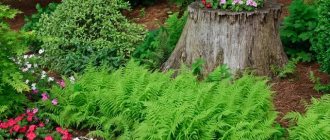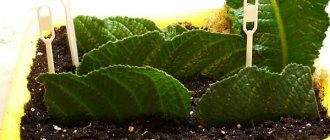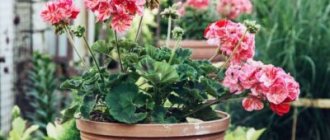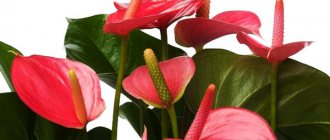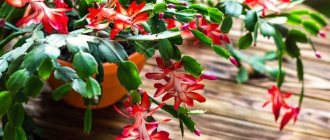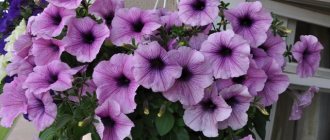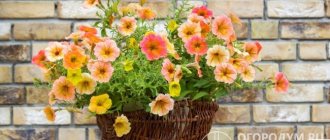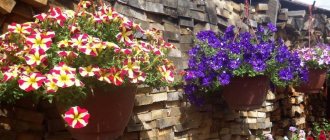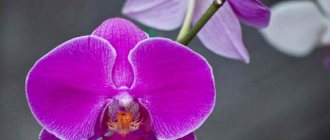Characteristics of hybrid petunia.
- Hybrid Petunias are members of the nightshade family.
- Hybrid petunias have a small sticky fluff.
- Stems come in three types: 1) branched, 2) erect, 3) creeping.
- The leaves are usually green in color and shaped like an oblong egg.
- Gardeners love petunias for their long bloom time and beautiful flowers.
- Flowers bloom gradually as shoots develop and emerge from the leaf axils.
- The flowers are shaped like a funnel and are usually divided into five petals.
- Pollination of petunia occurs with the help of moths and often very large ones.
- The fruit is a capsule containing several seeds.
- In general, Hybrid Petunias are perennials, but they are often grown as an annual plant.
- Petunias have many varieties, and breeders often invent new ones.
There are two main varieties of petunias - cascading , whose shoots are very long, and hanging ones , which create carpets of flowers.
Filigree cousins are also sometimes distinguished; the name was given in honor of the person who created this variety. The plants are very small and attractive looking.
Constellation Aries (Constellation Aries, Constellation Aries)
An incredible series of petunias called Constellation will not leave anyone indifferent. The speckled petals resemble the night sky with stars scattered across it; they fascinate and make you fall in love at first sight.
The series is represented by several varieties. One of them is Constellation Aries, which means “Constellation Aries”. The purple petals of the flowers of this variety are covered with snow-white spots of different sizes and shapes.
Petunia Constellation Aries semi-ampeloid. The height of an adult bush is 20-25 cm, the length of side shoots is 40-50 cm. The bush branches well and easily forms a hat of stems and flowers. Flowering is abundant and long lasting.
What types of petunias are there?
Let's look at several specimens and their characteristic features.
The first specimen is a mixture of colors and its characteristic features.
- The mixture of colors is represented by large bushes.
- The height of each is about thirty-five to forty centimeters.
- Flowers with wavy petals and different colors.
The second example is a charming waterfall and its characteristic features.
- One of the popular cascade forms is a charming waterfall, the average height is up to sixty-five to seventy centimeters.
- The flowers are satiny and the plants are weather resistant.
The third copy is Evening sunshine, and its characteristic features.
- Evening sunshine, represented by small bushes.
- The average height is fourteen to fifteen centimeters.
- The flowers have a sky blue hue.
- The diameter of each inflorescence is about four to five centimeters.
- Loves light very much.
- Tolerates drought well.
The fourth copy is trilogy, and its characteristic features.
- Creeping petunia trilogy, average height about twenty-two to twenty-three centimeters.
- Flowers come in different shades. This variety is often used to create flower carpets.
The fifth copy is Big lapa sophistry barking, and its characteristic features.
- Big lapa sophistry lime. Bushes about twenty-five to thirty centimeters high.
- The flowers have a double color. Colors may be completely different.
- The plant is neutral towards the soil.
The sixth specimen is Mother, and its characteristic features.
- Mother small variety.
- The second characteristic feature of this variety.
- The flowers are bright purple. The diameter of one flower is about seven to eight centimeters.
- They tolerate diseases well.
The seventh copy is Loyalty, and its characteristic features.
- Fidelity is also a small variety with salmon-colored flowers.
- The diameter of one flower is about five to six centimeters.
- Flowering returns after rains.
The eighth copy is Star Rain, and its characteristic features.
- Star Rain, a representative of the densely branched species of petunias.
- The leaves are narrow.
- The average height of the bush is twenty-five to thirty centimeters.
- The flowers resemble stars, usually bright pink or purple.
The ninth copy is Laguna, and its characteristic features.
- Lagoon, the height of the bushes is up to thirty to thirty-five centimeters.
- Large flowers come in completely different colors.
- The diameter of one flower is fourteen to fifteen centimeters.
The tenth copy is tango, and its characteristic features.
- Compact bushes up to twenty-five to thirty centimeters high are called tango.
- The flowers are bright pink.
- The diameter of one inflorescence is about seven to eight centimeters.
The eleventh copy is Isabella, and its characteristic features.
- Isabella has meter-long stems.
- The flowers are crimson and quite large.
- Resistant to diseases.
The twelfth specimen is Few the blues lime coral, and its characteristic features.
- Thick, lush, average height is about thirty-five to forty centimeters.
- The flowers are yellow and large.
The thirteenth specimen is Pendolino rose eye, and its characteristic features.
- The flowers are pink.
- The diameter of one inflorescence is about two centimeters.
- The height of the bush is approximately fifteen to twenty centimeters.
- The plant tolerates low and high temperatures well.
The fourteenth copy is Capella, and its characteristic features.
- The chapel is represented by small bushes.
- The height of each is about fifteen to twenty centimeters.
- The average diameter of the flowers is about nine to ten centimeters, the center is purple, the border is white.
The fifteenth specimen is Carolina, and its characteristic features.
- Carolina is a representative of upright petunias.
- The growth of one bush is fifteen to sixteen centimeters.
- The flowers are quite large, about twelve to thirteen centimeters in diameter.
- Damp, acidic soils will be detrimental to the plant.
For flowerpots
To decorate balconies and terraces, flower pots and hanging baskets are used, where flowers are planted. Petunias with long shoots strewn with flowers look beautiful. The shoots go down in waves. Varieties with this bush shape are called cascading and ampelous.
Cascade form
The plant forms a spreading bush, on which shoots grow upward and to the sides. Having grown to a certain length, they fall down under their own weight, forming a cascade. The group of cascade varieties requires spacious containers (at least 5 liters per plant) and good lighting for the bush from all sides.
The plant must be shaped by removing excess stems to prevent thickening.
The best varieties:
Gioconda
The petunia variety blooms profusely and grows vigorously. Meter-long shoots, during the time of active flowering, are completely covered with flowers. The buds can be colored pink, orange, violet, purple. The petals may have white stripes (blue-white Farao hybrid).
Opera Supreme
The powerful bush reaches a diameter of 120 cm, with a shoot height of 25-30 cm. When planted in a pot, the bush grows in the form of a lush cloud. The effect is enhanced when planting the Lavender hybrid, a soft lavender shade. The Pink Morn hybrid has bright pink flowers.
Niña
A cascading group of plants with small and numerous flowers. The size of the dense dense bush is 20 by 60 cm. The flowers do not exceed 3 cm in diameter. Varieties of bud colors:
- Blue sky (blue);
- Red (scarlet);
- Parple (lilac-violet);
- Lavender (lavender);
- White (white).
Petunia Mammi and Ninya from Biotechnics
Marco Polo
A plant with large flowers of simple shape, abundantly covering meter-long shoots. Colors: deep blue, lemon, wine, red with white stripes, pink.
Starlight Night
Mint Lime
Hybrids of the “Volna” series
The most unpretentious “super cascades”, blooming even in short daylight conditions and do not require special care. The length of the shoots is 90 cm, they are covered with flowers, up to 7 cm in diameter. Colors: red, coral, lilac-white, plum, silver, blue.
Waterfall
A group of terry petunia hybrids. Shoots reach 50 cm in length. The flowers are densely double, up to 13 cm in diameter. Colors: pink, white, lilac, lilac.
Blue waterfall @7dach
Imperial
A plant with meter-long shoots and large simple flowers, 6-7 cm in diameter. Petunia is unpretentious and cold-resistant. Colors: soft pink, blue, red.
@Lola66, Frau Flora
To obtain lush and long-lasting flowering, it is necessary to feed petunia every 10 days.
Ampelous petunias
Unlike cascade varieties, ampelous petunia forms shoots that immediately go down. The length of flexible shoots can reach one and a half meters. Such flowers are used for landscaping vertical surfaces.
The best varieties:
Opera - shoot length 90 cm, flower diameter 5 cm, shades: white, blue, pink, coral.
Explorer - meter-long flexible shoots are dotted with flowers up to 7 cm in diameter, pink, white or red, the variety is resistant to salt.
Opera Supreme White
Explorer Blue
Shock Wave - shoots reach a length of 85 cm, flowers are 5 cm in diameter, colors: burgundy, blue, pink, purple.
Snow Queen (hybrid) - stem length 80 cm, snow-white flowers, up to 10 cm in diameter.
Diamond - shoots grow up to 100 cm, flowers are pink, white, red, purple, up to 5 cm in diameter.
Shock wave coral crash
Diamond Parple F1
The Snow Queen
Among flower growers, the ampelous variety is considered less demanding in terms of growing conditions than cascading petunia. However, it is necessary to choose fertile soil for plants, place them in a bright place, and regularly water and feed them.
On the portal you will find a detailed analysis of varieties of ampelous petunias with photos and descriptions.
Read
Representation of the hybrid petunia variety.
Let's consider the characteristic features of this variety.
Hybrid petunias are descendants of wild petunias from South America.
Flower growth largely depends on the variety, with an average of twenty-five to thirty centimeters.
Petunias bloom throughout the season until the onset of cold weather.
The palette of petal shades is huge. Flowers can be white, violet, pink, purple, cream and many other shades.
The best place to grow petunias is a place protected from winds and rain and well lit by the sun. There are varieties that tolerate wind well, but on balconies that are not protected by anything, it is better not to plant varieties that have small flowers.
To ensure that the flowers do not begin to shrink during flowering and that flowering occurs on time, it is necessary to provide the plants with proper lighting.
What it is?
More than 200 years ago, in the tropical zone of Brazil and South America, the first species of petunia were discovered. Since the word “petunia” is translated as “tobacco”, it was assigned to the Tobacco genus. Today, petunia belongs to the genus of shrubby, herbaceous plants, and is represented by a variety of more than 40 types of flowers.
It can please the eye both for one season and for a long time. The appearance of petunia is most often represented by weaving inflorescences . However, sometimes it is also found in the form of shrubs with straight or creeping stems. The stems contain a lot of ovaries, which over time turn into beautiful flowers that have an attractive appearance, but most often a repulsive smell.
How to properly care for petunias?
Let's look at a few recommendations for caring for this variety.
In order for Hybrid petunias to bloom well and for a long time, they need a lot of soil. Flower soil containing fertilizers is used as the main soil. From these fertilizers, the plant will receive nutrients at the beginning of its life, but in the future it will have to be fed.
There are two simple rules for caring for petunias.
Firstly the soil should not be allowed to dry out. If the soil dries out, the risk of insects and diseases will increase and the petunias will not be able to recover completely.
When the summer heat hits, it is necessary to water the plants twice a day. It is better to do this during the day and with warm water. Leaves should not cool suddenly at night, as this can harm the plants.
The second rule is the right fertilizers. To apply fertilizer as correctly as possible, it is better to do this during each watering. Choose the dose recommended by the manufacturer and divide it into a certain number of days and fertilize the plants every day.
You can choose a package that gives a seven-day dosage, divide it into seven days and give the plant a little each day. This method will be better than transferring fertilizers. Fertilizers should be in light form, accessible to plants.
Petunias love acidic soil. If the plant grows in a pot, then the acidity will decrease very quickly. When the alkalinity of the soil becomes elevated, the flowers and leaves gradually begin to turn yellow. This is due to the fact that iron in alkaline soils is poorly absorbed.
Plants can also be grown in open ground. Any variety can be grown in open ground.
For flower pots, you can use stands in the form of trees. You can order wooden coasters from a locksmith or find them in a specialty store. If you place petunias in such a structure, you need to remember about watering, it can either be automatic or from the topmost to the lowest plant.
Reviews
According to reviews from professionals and amateur flower growers, the following varieties of petunia hybrids are very common in gardening:
- Kakadu is a multi-flowered low variety, deep purple with white spots;
- large-flowered Evening sun pink;
- white lace veil;
- fringed blue butterfly;
- Venose – white-lilac with blue veins;
- white Rheingold;
- pink large-flowered Camilla.
Hybrids grow well in heavy and light clay soils.
You need to pay special attention to them in the first month of growth. Excessive watering or dryness can kill the plant.
They also turn on additional lighting (they provide additional lighting in the morning and during the day, and turn on dim lights at night).
When pulling out seedlings, gardeners add substrate to the container.
How to grow seeds?
Gardeners usually buy ready-made petunia seedlings. If you grow seedlings yourself, no one guarantees that the result will be of high quality. Let's look at a few recommendations for growing this variety from seeds.
The soil in which petunia seeds are sown is special. Seedlings are very sensitive to fungi, so they should not be in the ground, just like weed seeds. When the seeds begin to germinate, average temperatures should be around twenty-one degrees around them. With the gradual germination of the plant, it is necessary to reduce the temperature to seventeen to eighteen degrees.
The picking process begins when the first leaves appear on the plants.
Seedlings should be removed once every two weeks.
The process of seed dispersal is lengthy. It starts in January.
In order for seedlings to grow well indoors, they need to be illuminated.
In the spring, before planting in open ground or an outdoor pot, you need to harden it.
At the end of summer, petunias can be propagated using cuttings.
It is recommended to use, root or move the cuttings for several weeks to a dark place where the air temperature will be lower so that the roots begin to sprout. When the roots are formed, each bush is formed, place it in a separate pot; in winter they can be grown at home.
Diseases and pests
| Blackleg Ways to fight:
| |
| Gray rot Ways to fight:
| |
| Aphid Ways to fight:
|
Diseases that often attack petunias.
What diseases and pests attack petunias?
The varieties of petunias appearing now are more resistant to various diseases. If diseases occur, you can spray the plants with fungicides. Spraying will be quite difficult due to the fact that the plant has many flowers and shoots. It will be difficult to treat all infected areas.
The first disease is Petunia Mosaic.
- The stems of the shoots begin to darken and become covered with spots.
- This disease is inherent in plants grown by cuttings.
- Flowering with this disease weakens and the plants gradually dry out.
- The virus is not transmitted through seeds, so they can be pulled out if possible.
The second disease is Alternaria.
- If white spots appear on the petals, this may be a sign of Alternaria blight.
- In the advanced stage of the disease, black stripes will appear on the stems.
The third disease is late blight.
- Late blight appears from the soil. Gradually, the plants begin to turn yellow from below and the leaves fall off.
The fourth disease is chlorosis.
- When a plant lacks iron or the soil is too acidic, chlorosis can occur. Fertilizers with a high ferrum content will help cure this disease, but it will be difficult.
New hybrids
A garden favorite among annuals is petunia. Its continuous flowering, bright colors, and lush bushes enchant everyone.
Every year new selections appear with new shades and undertones.
For example, the new Maxi series hybrids look like this:
- Limbo GP Pink;
- Limbo GP Orchid;
- Limbo GP Burgundy Picotee;
- Limbo GP Rose Picotee.
Let's consider the unsurpassed, newest petunia hybrids Night Sky and BabyDoll, bred by German breeders, and their varietal characteristics.
Scientists managed to create an unusual pattern on the petals of new varieties. Luxurious shades of buds are decorated with spots, white peas, and strokes.
Night Sky is a variety of purple, violet or deep blue color, where interspersed with stars are scattered on the petals. When the bush blooms, it creates the impression of a reflection of the starry sky. This is an ampelous hybrid with branching shoots of about 1 meter. The hanging bush looks very lush, densely leafy, all covered with buds.
Baby Doll is very elegant, fuchsia pink with white dots and petunia spots. The flowers are framed by dense foliage, the shoots are tightly intertwined.
In general, all new varieties are quite versatile. They will decorate any composition and present themselves with dignity in a separate planting.
How can you use petunias?
Hybrid petunias can decorate almost anything; they are often planted in hanging pots, cache-pots, used to decorate flower beds, parks, houses, plots and much more.
Petunia looks good in vertical flower beds.
Hybrid petunias are often used in landscape design and can be grown as a houseplant.
Features of reproduction
Reproduction of petunia is possible by using seeds, seedlings, cuttings:
- The most elementary way is to use seedlings . However, the high price may be a significant disadvantage.
- Cuttings are in demand among experienced gardeners. It allows you to get a beautiful bush with frequent flowering. The most suitable period is considered to be the beginning of spring.
- Before separating the cutting from the main plant, you need to make sure that there are no various diseases.
- Next, you should ensure the growth of roots by placing the petunia in water or sand.
- To stimulate growth, it is necessary to pinch the leaves.
- The least popular method of propagating petunias is the seed method . It is always accompanied by certain problems and difficulties. Seeds must be planted in the soil one at a time, and this is sometimes impossible due to their very small size. Also, planting seeds is preceded by soil preparation, which includes many nuances.
